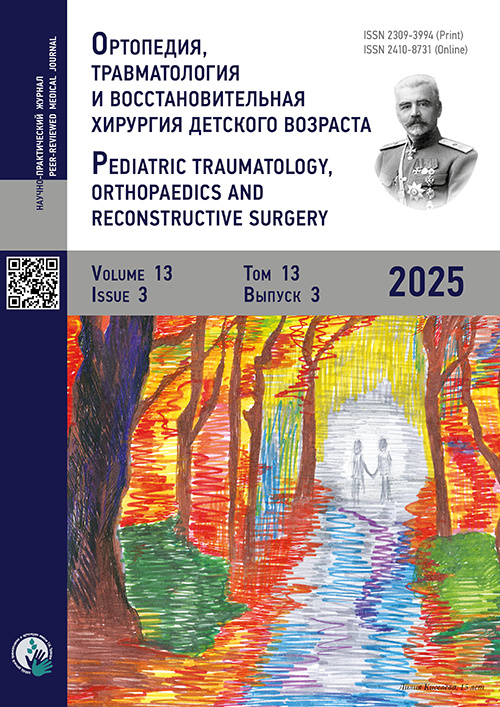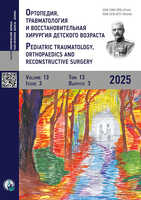Pediatric Traumatology, Orthopaedics and Reconstructive Surgery
期刊介绍
Pediatric Traumatology, Orthopaedics, and Reconstructive Surgery为季刊,创刊于2013年,是由Turner Scientific Research Institute for Children's Orthopedics of Ministry of Healthcare of Russian Federation 与 Eco-Vector LLC创办的科学学术期刊。
本刊目标读者包括科研人员、内科医师、创伤骨科医师、烧伤医师、小儿外科医师、麻醉医师、儿科医师、神经科医师、口腔外科医师及相关医学领域的所有专科医师。
主编
教授Baindurashvili A.G. (ORCID: 000-0001-8123-6944)
期刊内容:
- 国内外临床及实验研究成果,外科疾病、烧伤及其所致疾病、肌肉骨骼系统损伤及病变的新型诊治方法研究与资讯;
- 发表于国际期刊的期刊主题要点、创伤及骨科护理方法与管理文章、案例研究、文献综述、论文摘要;
- 学术会议与活动的回顾及通知。
索引
- 本刊被列入“科学学位论文必投的领先同行评议期刊目录”。
本刊已被以下国际数据库及各目录收录:
- 俄罗斯科学引文索引(Russian Science Citation Index)
- SCOPUS
- Embase
- EBSCO
- DOAJ
- Google Scholar
- Ulrich's Periodical Directory
- WorldCat
- CNKI
封面:Turner Institute for Children's Orthopedics就诊患者的画作
最新一期
卷 13, 编号 3 (2025)
- 年: 2025
- ##issue.datePublished##: 30.10.2025
- 文章: 12
- URL: https://journals.eco-vector.com/turner/issue/view/13746
- DOI: https://doi.org/10.17816/PTORS.133
Clinical studies
儿童桡骨远端不稳定性骨折手术治疗结果的比较分析
摘要
论证。桡骨远端骨折在儿童肌肉骨骼损伤的整体构成中仍然占据领先位置。这些患者治疗效果不佳,不仅导致需要再次手术,而且伴随上肢功能活动受限。鉴于上述情况,针对儿童桡骨远端不稳定性骨折,寻找能够最大程度降低并发症风险并改善康复效果的新型有效外科治疗方法,仍具有重要的现实意义和价值。
目的。对比两种不同方法在儿童桡骨远端不稳定性骨折手术治疗中的疗效。
方法。共完成83例儿童桡骨远端不稳定性骨折的手术治疗。第1组患者(n=52)接受了采用改良顺行弯曲克氏针髓内固定方法的手术(发明专利号2835501,2025年1月20日);第2组患者(n=31)接受了采用逆行克氏针髓内固定方法的手术。在术后1、3、6和12个月对治疗结果进行评估,评估内容包括手术并发症、邻近关节挛缩、手术时间及骨折愈合速度。统计学分析采用Mann–Whitney检验、Yates校正的χ2检验和Fisher精确检验。
结果。结果显示,与接受改良顺行植入金属内固定方式手术的患儿相比,接受逆行克氏针髓内固定术的患儿在术后并发症的发生率和严重程度方面均更高,临床结局也较不理想。在技术操作特点方面,作者提出的改良手术方法与经典方法相比并不更复杂,这一点通过两组手术时间无显著差异得到了证实。在接受改良方法治疗的患儿中显示出更高的远期功能学结果。这为将该方法视为不仅具有竞争力,而且更具优选性的治疗方式提供了依据。
结论。研究结果表明,采用所提出的改良方法治疗儿童桡骨远端不稳定性骨折具有使用的合理性,其目的在于降低术后并发症风险并改善康复治疗效果。
 237-246
237-246


儿童远节指骨撕脱性骨折手术治疗方法的分析
摘要
论证。撕脱性关节内骨折约占儿童远节指骨损伤的18%。截至目前,针对这类损伤的外科治疗尚无统一的途径。作为开放复位的替代方法,Ishiguro技术具有潜在优势,但其在儿童创伤学中的应用经验仍然有限。
目的:通过对比分析开放复位伴外周骨片克氏针固定与Ishiguro技术下的微创复位及骨接合效果,确定儿童远节指骨关节内撕脱性骨折的最佳外科治疗方案。
方法。在Children’s City Clinical Hospital No. 9创伤科第1和第2部门开展前瞻性队列研究,地点为Yekaterinburg。纳入29名儿童,均为关节面移位超过1/3的远节指骨关节内撕脱性骨折患者。研究组(n=15)采用Ishiguro微创复位与骨接合方法;对照组(n=14)采用开放复位与克氏针固定外周骨片。术后第3天和第7天对针道局部炎症反应进行宏观评估。去除内固定后第 1、2、4 周使用量角器测量远端指间关节活动度。
结果。研究组远端指间关节活动度恢复显著优于对照组:去除内固定后1周分别为17.80±7.43°vs 7.79±3.40°(p<0.001);2周为 57.47±13.11° vs 28.86±12.09°(p<0.001);4周为89 [85; 90]° vs 78.50 [77.25; 83.00]°(p<0.001)。在术后第3天和第7天对钢针植入部位进行宏观评估时,两组在针道局部炎症反应方面未见统计学差异(p>0.05)。所有病例均实现骨折愈合。对照组1例出现外周骨片碎裂的不良事件。
结论。Ishiguro骨接合技术具有良好的技术可重复性、微创性和优良的功能恢复效果,可推荐作为儿童远节指骨关节内撕脱性骨折的首选治疗方法。
 247-255
247-255


9–12岁软骨发育不全患儿交叉延长股骨与对侧小腿时股骨牵张再生骨修复性骨生成的超声学标准
摘要
论证。对修复性骨生成的动态评估具有重要意义,因为股骨再生骨的成熟度决定了对侧小腿延长的手术时机,以及患者的整体住院周期。
目的:探讨软骨发育不全患者股骨牵张再生骨修复性骨生成的超声学标准,以作为开展对侧小腿手术的指征。
方法。纳入9–12岁软骨发育不全患者(n=37),其中在6–7岁时曾接受第一阶段双侧小腿延长治疗。在第二阶段治疗中,先进行股骨延长,随后进行对侧小腿延长。股骨延长采用双皮质截骨术。牵张期为63±3天,延长幅度为6.5±0.5 cm。对骨再生组织进行超声扫描(AVISUS,Hitachi,日本),在牵张开始后的第7、20、30、60天以及固定期内每月各进行一次。对结果的数学处理采用适用于小样本的变异统计学方法,显著性水平设定为p≤0.05,差异的显著性采用Wilcoxon W检验进行判断。
结果。牵张过程中,在骨再生组织的中间带观察到线性高回声片段的数量和大小逐渐增加。为维持牵张,在中央带保留了“生长带”,其表现为低矿化层,声学密度为65–85个单位。至牵张末期,超声显示高回声区缩小,结缔组织间隙减少,中间带逐渐被填充。在固定早期,由于矿化过程活跃,片段及再生骨的声学密度分别达到 198±9.0 和 158±4.5 个单位(与牵张初期相比,p≤0.05),提示患肢可承受适度负荷,并具备开展对侧小腿手术的条件。
结论。9–12岁软骨发育不全患儿在进行股骨牵张延长时,股骨再生组织修复性骨生成的超声学标准,可作为开展对侧小腿延长手术的指征,包括:在整个牵张期间均可见再生组织形成典型的分区结构;在所有可视化的再生组织带内均未发现局灶性病灶;至牵张期末,再生组织的声学密度较治疗初始水平提高约50%;在固定期开始时,再生组织的高回声带宽度降低至所达延长量的45–48%。
 266-274
266-274


采用股骨伸直截骨术矫正脑瘫儿童膝关节屈曲挛缩:矢状面参数评估
摘要
论证。膝关节屈曲挛缩是脑瘫儿童最常见的畸形之一,显著影响步态、能量消耗、直立能力和生活质量。矫正方法包括软组织手术(腘绳肌延长术)和骨性手术(股骨伸直截骨术)。软组织手术创伤较小且病理生理学合理,但部分研究提示其可能因增加骨盆前倾而影响矢状面平衡。股骨伸直截骨术传统上被认为对矢状面参数中性,但多数既往研究将其作为联合手术的一部分,难以单独评估其作用。因此,有必要研究股骨伸直截骨术对脑瘫儿童整体矢状面参数的影响。
目的。评估矫正性股骨伸直截骨术对脑瘫儿童膝关节屈曲挛缩及脊柱–骨盆矢状面参数的影响。
方法。纳入2022–2025年在H. Turner National Medical Research Center for Children’s Orthopedics接受治疗的14例脑瘫患儿。所有患儿均接受股骨髁上伸直截骨术,并采用带角度稳定性的钢板固定(LCP PHP 90°)。共完成26例截骨术。其中3例使用了专为骨密度降低的脑瘫患儿设计的新型内固定装置。术前及术后6个月,评估临床指标(主动伸直缺损、挛缩程度、腘绳肌角)及影像学参数(pelvic incidence、pelvic tilt、sacral slope、lumbar lordosis、thoracic kyphosis、sagittal vertical axis)。
结果。手术显著矫正了膝关节屈曲挛缩并改善了主动伸直。在影像学指标中,仅lumbar lordosis出现统计学显著变化(+4.3±13.5°,p=0.049)。其余参数无明显差异。相关性分析未发现临床指标与影像学参数变化之间的相关性。
结论。股骨伸直截骨术是治疗脑瘫儿童膝关节屈曲挛缩的有效方法,不会引起整体矢状面失衡。Lumbar lordosis的增加属于适应性改变,并未导致失代偿。新型内固定装置的首次应用显示出固定的技术可行性,并在低骨密度情况下具有应用前景。
 256-265
256-265


儿童与青少年尾骨痛的主要原因:体育活动对疼痛综合征发展的影响
摘要
论证。尾骨痛是一种表现为尾骨区域持续且剧烈疼痛的疾病,在儿童和青少年中虽罕见,但因病因复杂多样,常在诊断与治疗上带来困难。
目的:分析从事体育运动与未从事体育运动的儿童和青少年尾骨痛发生的原因。
方法。分析2010年1月至2025年3月期间906例因尾骨疼痛就诊于咨询诊断科患者的门诊病历。研究内容包括病史、体格检查及影像学资料。
结果。纳入研究的患者年龄为9–18岁。女患者人数是男患者的5.5倍。多数儿童未从事体育运动。 37%的患者被诊断为创伤性尾骨痛。多数病例是在学校或户外跌倒时臀部着地而致伤。在创伤性尾骨痛患者中,从事体育运动者仅占5.1%。非创伤性尾骨痛的原因包括尾骨动态不稳定、后倾畸形、 尾骨棘突以及体重下降。在40.7%的病例中未能明确病因。在从事体育运动的患者中,超过一半的病例(64%)的尾骨痛与在训练过程中因长期静态或动态的尾骨超负荷所导致的尾骨动态不稳定相关。
结论。儿童与青少年最常见的尾骨痛类型为创伤性和特发性尾骨痛。体育训练中发生的尾骨损伤比日常生活中少一半。对儿童运动员来说,患者在马术、自行车运动、舞蹈和芭蕾中承受的重复性过度负荷在尾骨动态不稳定的发展上被认为是不安全的。在儿童运动员中,尾骨痛的预防可以建立在掌握正确的运动技术、逐步增加训练负荷和使用防护装备的基础上。
 275-282
275-282


New technologies in trauma and orthopedic surgery
一种用于评估脑瘫患儿髋臼解剖位置的新方法
摘要
论证。目前用于评估脑瘫患儿髋臼畸形程度的方法主要只能描述其形态。而在关节逐渐失稳过程中,髋臼在骨盆环内空间取向的改变尚缺乏系统研究。
目的:基于线性指标法,对脑瘫患儿稳定及不稳定髋关节中髋臼相对于骨盆环要素的空间取向参数进行评估。
方法。开展横断面研究,纳入21名 9–15岁脑瘫患儿(共42 个髋关节)。每位患者一侧髋关节稳定(21例,第一组),另一侧为不稳定(半脱位或脱位,21例,第二组)。本研究采用作者自拟的方法,即在螺旋计算机断层扫描上通过4项作者提出的线性指标来测定髋臼的空间取向,该方法适用于稳定和不稳定的髋关节。
结果。零假设检验显示两组髋臼空间取向参数差异无统计学意义。然而,在采用定量评估方法时,不稳定髋关节组显示出以下趋势:从第1骶椎最前突点(SI)至髂前下棘、坐骨棘以及Y形软骨与闭孔嵴交点的距离缩短,而从SI至Y形软骨与耻骨嵴交点的距离则延长,与稳定髋关节组相比。逐例对比发现,这些指标在33–42%的病例中差异超过5%,具体取决于测量参数。
结论。本研究提出了一种新的诊断方法——髋臼在骨盆环内空间取向的测定。该方法能够识别髋臼的多平面移位,而不受形态学变化的限制。群体数据与个体数据之间的不一致提示需进一步研究。
 283-292
283-292


Clinical cases
新生儿Mohr综合征(口-面-指综合征II型)合并肢体发育畸形的多指并指畸形:骨科实践中的罕见病例
摘要
论证。Mohr综合征(口-面-指综合征II型)是一种罕见的常染色体隐性遗传疾病,临床特征包括颅颌面、口腔和手指畸形,部分病例可伴中枢神经系统和心脏发育异常。在骨科实践中,手足的多指畸形和并指畸形尤为重要,因为它们直接影响肢体功能及患者生活质量。
临床观察。本文报道一例足月新生男婴,系非近亲婚配父母的第一胎。患儿出生时即表现呼吸窘迫综合征及多发性先天畸形。主要临床表现包括:正中唇裂、前额多毛、眶距增宽、鼻梁宽大,以及双手双足多并指畸形,伴双侧大脚趾重复畸形。进一步检查发现右心室双出口畸形及Dandy–Walker综合征。临床诊断基于典型表型特征确立为Mohr综合征,未进行基因学检测。在本例中,肢体发育异常与Mohr综合征所描述的肌肉骨骼系统病理性改变相一致。
讨论。双侧后轴性与前轴性多指畸形,尤其伴有双足大脚趾重复畸形及手部畸形时,可高度提示口-面-指综合征II型,并有助于与I型综合征的鉴别。对骨骼肌肉系统畸形的早期识别能够促使患儿及时转诊至骨科。文献回顾表明,早期规划手术干预对于预防综合征相关多指畸形所致功能障碍具有重要意义。
结论。在本罕见病例中,Mohr综合征(口-面-指综合征 II 型)的诊断基于典型的颅颌面畸形和手指发育畸形。患儿因肢体畸形已出现功能受限,因此导致其早期就诊于骨科。作者认为,当发现此类症状组合时,应考虑Mohr综合征。
 293-298
293-298


重度鸡胸畸形青少年的外科治疗(临床观察)
摘要
论证。鸡胸畸形(pectus carinatum)是一种由胸骨和肋软骨异常引起的胸廓畸形,在各种胸廓畸形类型中,其发生率位居第二。据不同作者报道,其发生率为8%–20%。本文报告了一例重度鸡胸畸形青少年的临床治疗结果,采用微创胸廓成形术以矫正复杂且僵硬的畸形。
临床观察。患者,17岁,接受了外科手术以矫正重度鸡胸畸形。手术采用微创方式,经胸膜内外及胸骨前方植入两枚T形钢板完成矫正。
讨论。对于重度鸡胸畸形,常规的根治性手术方法包括切除畸形肋软骨的软骨下段、胸骨截骨术和/或剑突游离、切除胸骨体下端并进行骨固定。然而,此类手术可能导致并发症:大出血、皮下血肿、皮肤营养障碍、胸肋复合体不稳,以及不满意的美容效果。微创胸廓成形术在矫正各种胸肋复合体畸形时,仍可能出现并发症,如心律失常、大血管神经损伤、内固定植入物不稳或移位,这些并发症可以通过外部装置对胸壁进行剂量化矫正或采用稳定的固定系统加以减少。然而,它也具有明显的优势:减少组织损伤,术后胸肋复合体稳定性可靠,并且在美容效果方面优于根治性胸廓成形术的乳下切口方式。
结论。本文报道了一例青少年极重度鸡胸畸形病例,伴有尖顶型和僵硬型特征,并且现代支具综合治疗无效。所述微创外科矫正方法较根治性治疗方式具有明显优势,可推荐应用于部分具有类似畸形的患者。
 299-306
299-306


Conradi–Hünermann综合征患儿脊柱后凸侧弯畸形的外科矫正(病例报告与文献综述)
摘要
论证。Conradi–Hünermann综合征,又称X连锁显性点状软骨发育不良2型(CDPX2),是一种罕见的遗传性疾病。其患病率为每100,000–400,000名新生儿1例,女性患者占比超过95%。在儿童脊柱外科中,后凸和后凸侧弯畸形因进展迅速并导致严重畸形而具有重要临床意义。然而,在俄罗斯国内文献中,有关该综合征诊断和治疗的研究报道仍极为有限。
临床观察。本文报道了一名3岁3个月Conradi–Hünermann综合征患儿的病史、遗传学检查及临床–影像学检查资料。展示了外科治疗结果,并讨论了手术策略选择的可能途径。
讨论。在低龄患儿(2–5 岁)中,脊柱在冠状面和矢状面形成严重畸形(超过50°Cobb角),是明确的不良预后因素。对于此类患者,在幼年期及时进行脊柱畸形的外科矫正,并通过多支撑金属内固定稳定矫正结果,是必要的措施,其目的在于防止神经功能缺损的发生以及在儿童后续生长过程中畸形的迅速进展。
结论。对疑似Conradi–Hünermann综合征的儿童应尽早进行临床和遗传学诊断。应监测其骨科状态,以便及时转诊至脊柱外科专家。进展性后凸侧弯畸形的治疗应包括早期外科干预。其可行方案可以是在不进行早期脊柱融合的情况下,通过多支撑金属内固定进行畸形矫正和稳定,并在必要时于随后的生长阶段实施分期矫正。
 307-318
307-318


Scientific reviews
髋关节发育不良保守治疗方法的演变(文献综述)
摘要
预防发育不良性髋关节炎的关键条件之一是对婴幼儿髋关节发育不良的及时、有效治疗。尽管该领域已有大量研究,但严重并发症仍然普遍存在,在40–86.3%的病例中导致发育不良性髋关节炎形成,在11–38%的病例中造成残疾,从而凸显了该问题的社会意义。本文在PubMed、Science Direct、Google Scholar和eLibrary等公开数据库中检索了1830–2025年间关于婴幼儿髋关节发育不良保守治疗的相关文献。长期以来,保守治疗始终是儿科骨科关注的核心问题之一。目前公认的婴幼儿髋关节发育不良的最佳治疗方法是功能性疗法,其核心在于通过逐步将股骨头复位并居中于髋臼,同时在保持关节活动度的情况下对下肢进行固定。近十年来,该领域发表了大量研究。许多学者在功能性疗法的基础上提出改进方案,研发并应用新的矫形支具,使髋关节保持活动,同时避免过度(>60°)外展,从而提升治疗的质量与效果。保守治疗方法的发展历程体现了儿科骨科的重要原则,这些原则至今仍具现实意义:早期发现病变、确诊后立即采用功能性疗法;在保守治疗缺乏积极效果时,及时转向手术治疗;及早识别需初始手术干预的畸形性髋关节脱位;对患者进行持续随访直至生长结束;在必要时进行康复,以预防早发性发育不良性髋关节炎。
 319-327
319-327


儿童股骨头缺血后畸形的外科治疗途径:文献综述
摘要
儿童股骨头缺血后畸形多由Legg–Calvé–Perthes病及股骨头缺血性坏死所致,可导致髋关节解剖与功能障碍,并引起早发性髋关节骨关节炎。治疗方法和手术时机的选择问题在当前仍具现实意义。本文对国内外有关儿童股骨头缺血后畸形外科治疗的科学文献进行了分析,旨在系统梳理现有手术方法,评估其疗效,并探讨其在儿童骨科中的发展前景.本文呈现了在PubMed、Cochrane和eLibrary数据库中的检索结果。在共获得的64篇文献中(2000–2023年,俄文28篇,英文36篇),有48篇涉及该类畸形的手术治疗.关节外手术在矫正缺血后畸形方面显示出中期疗效,但可能导致并发症,如骨骺生长板和大转子骺板的早闭,从而引起关节面相容性的下降。近年来,伴随外科髋关节脱位的关节内手术已得到广泛应用。该方法能够在术中直接评估股骨头的状况、形态和结构,从而最大限度地实现其解剖学修复。研究结果表明,在儿童髋关节不同疾病类型下,股骨头多平面畸形若治疗不及时或不恰当,将导致关节功能的持续丧失,并造成患者的早期致残。文献分析表明,关节内手术在治疗儿童股骨头缺血后畸形方面可能具有一定疗效。然而,要更加客观地评价其对疾病后续进展的影响,还需要对治疗的远期结果进行分析。
 328-338
328-338


骨的神经支配。植物性神经支配。第二部分(文献综述)
摘要
外周神经参与骨的发育、修复和重塑。交感神经系统构成中枢神经系统与骨之间的主要纽带之一,这一点已通过多项解剖学、药理学和遗传学研究得到证实,尤其涉及骨细胞中经由β-肾上腺素能受体的信号传递。本文分析了有关自主神经系统在骨组织稳态调控中作用的文献。数据检索于PubMed、 Google Scholar、Cochrane Library、Crossref、eLibrary等数据库,涵盖英文和俄文资料。体外和体内实验数据显示,肾上腺素能神经结构可通过同时增强骨分解和抑制骨形成而导致骨量丢失。胆碱能神经结构的激活则能抑制骨吸收,从而增加骨量。自主神经系统对骨重塑的影响及其主要机制多来自于啮齿类实验动物模型的研究,但这些结果在人类临床病理生理学中的意义至今仍存在争议。然而,无论其未来的有效性和实际应用如何,这些数据仍构成进一步研究的有前景基础。
 339-347
339-347









